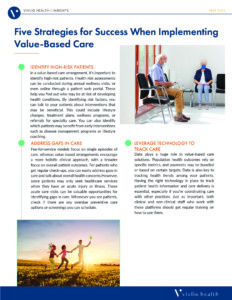The shift to value-based care from traditional fee-for-service models has changed the way payers reimburse healthcare providers. Rather than reimbursing for the volume of services provided, value-based care arrangements reward overall patient health outcomes. It’s not surprising that these models have been gaining traction in recent years, and for clinicians, it’s not just about changes in billing.
If your practice is making the shift toward value-based care, there are some key strategies that can go a long way to setting the stage for success. These five strategies for implementing value-based care are a good place to start.
1. Identify high-risk patients
In a value-based care arrangement, it’s important to identify high-risk patients. Health risk assessments can be conducted during annual wellness visits, or even online through a patient web portal. These help you find out who may be at risk of developing health conditions.
By identifying risk factors, you can talk to your patients about interventions that may be beneficial. This could include lifestyle changes, treatment plans, wellness programs, or referrals for specialty care. You can also identify which patients may benefit from early interventions such as disease management programs or lifestyle coaching.
2. Address gaps in care
Fee-for-service models focus on single episodes of care, whereas value-based arrangements encourage a more holistic clinical approach, with a broader focus on overall patient outcomes. For patients who get regular check-ups, you can easily address gaps in care and talk about overall health concerns.
However, some patients may only seek healthcare services when they have an acute injury or illness. These acute care visits can be valuable opportunities for identifying gaps in care. Whenever you see patients, check if there are any overdue preventive care options or screenings you can schedule.
3. Leverage technology to track care
Data plays a huge role in value-based care solutions. Population health outcomes rely on specific metrics, and payments may be bundled or based on certain targets. Data is also key to tracking health trends among your patients. Having the right technology in place to track patient health information and care delivery is essential, especially if you’re coordinating care with other practices. Just as important, both clinical and non-clinical staff who work with these platforms should get regular training on how to use them.
4. Communicate with other clinicians
With value-based care, the care your patients get from other clinicians can directly impact your bottom line. If your patients need to seek care from specialists, or if they have critical care situations and need hospital care, it’s important that you’re proactive about coordinating their care. Communicating with other care providers can help avoid costly overlaps in care and other pitfalls. Sharing data securely through cloud based, secure platforms like Vivlio, can make it easy to communicate with other clinicians.
5. Share data securely
Sharing patient data often is necessary to ensure the best outcomes for your patients. When you need to share protected health information (PHI), it’s crucial to ensure you do it safely to protect your patient’s privacy. When sharing data between other clinicians across the care continuum, you need a solution that is agile enough to work across multiple platforms safely and securely.
Cloud based applications make it easy to share authorized records between clinicians and with patients. They use an automated workflow process to track records, ensuring that the right document goes to the right person with the right authorization at the right time — every time.
The shift to value-based care can seem daunting, but there are things you can do to help build a path toward success.




